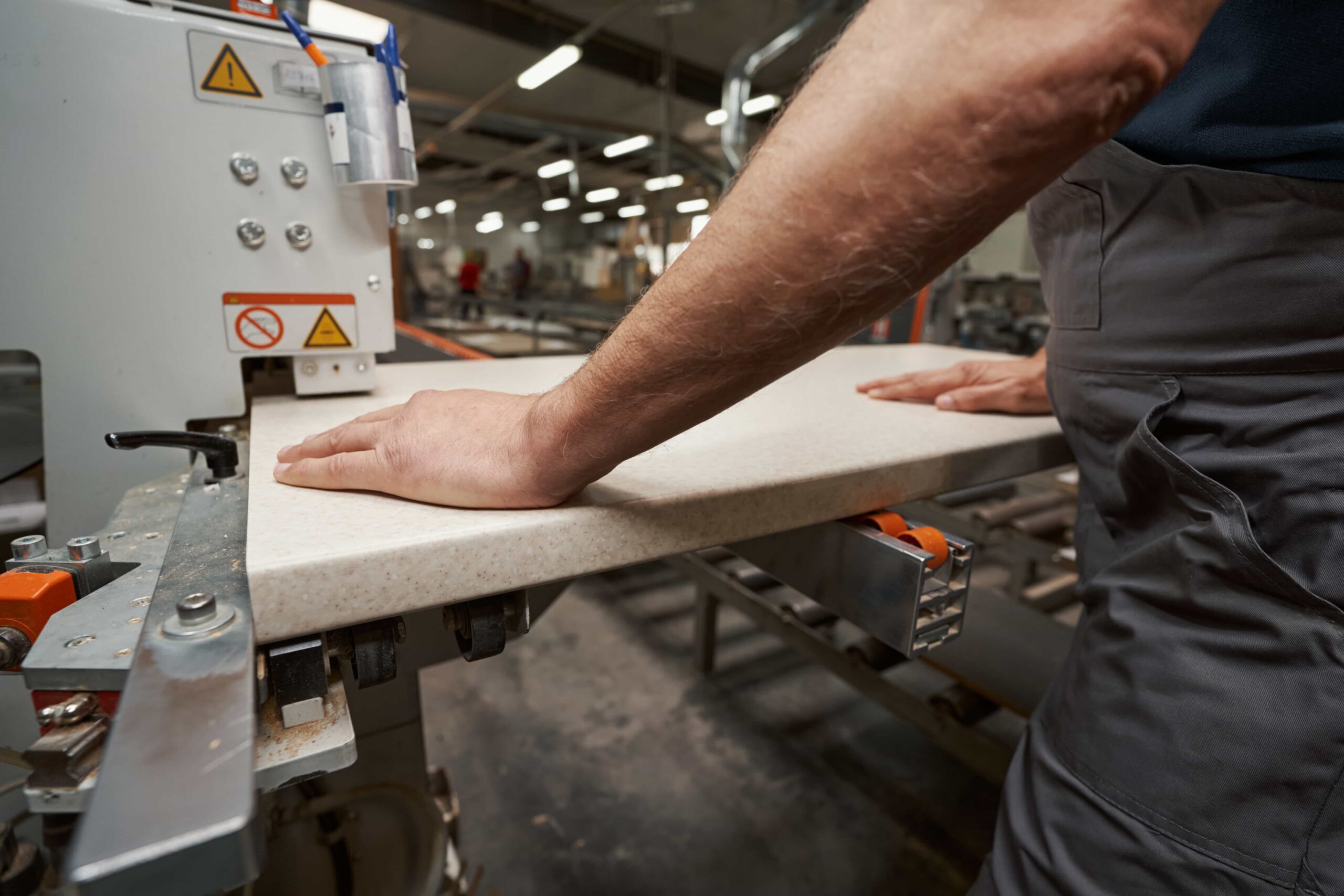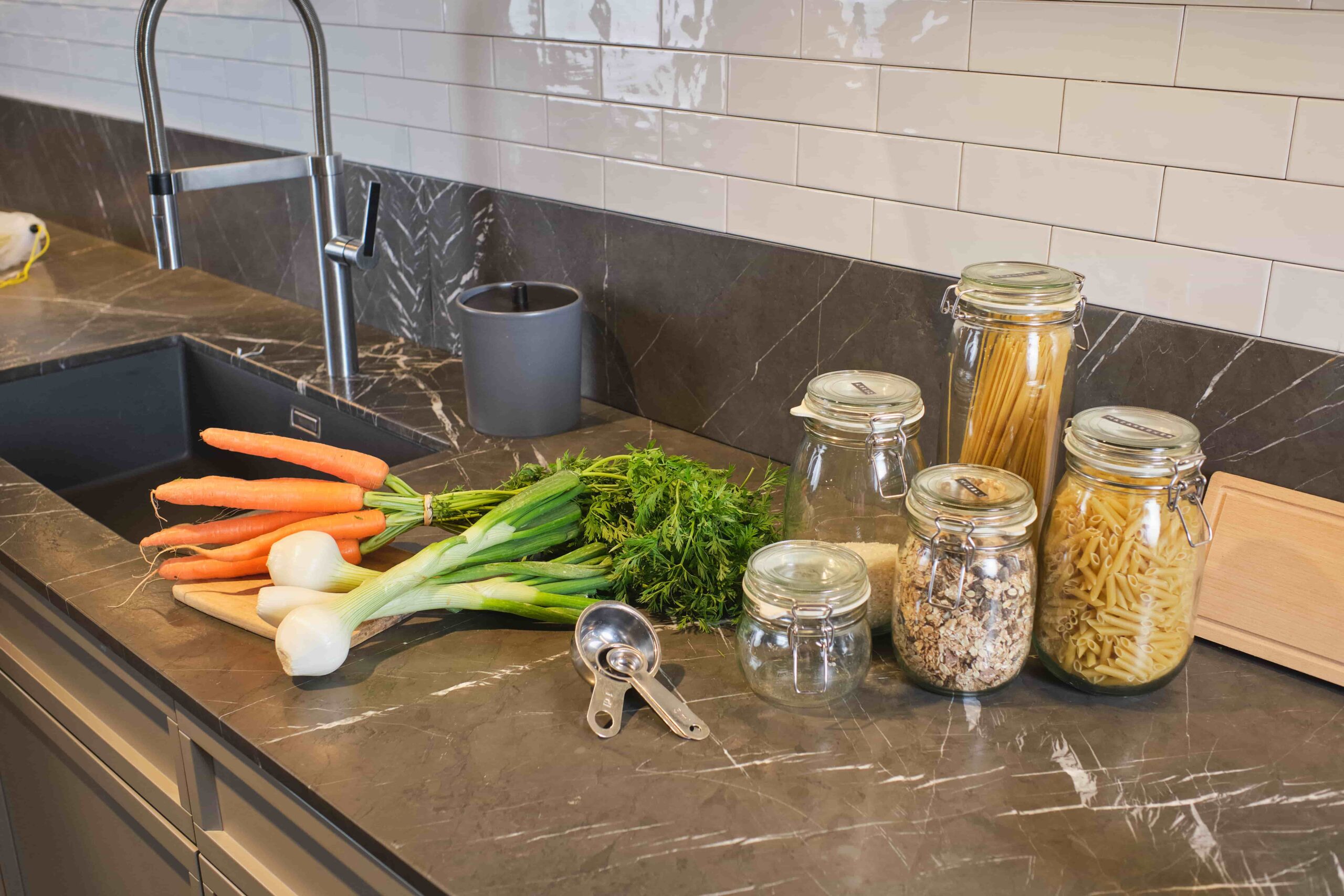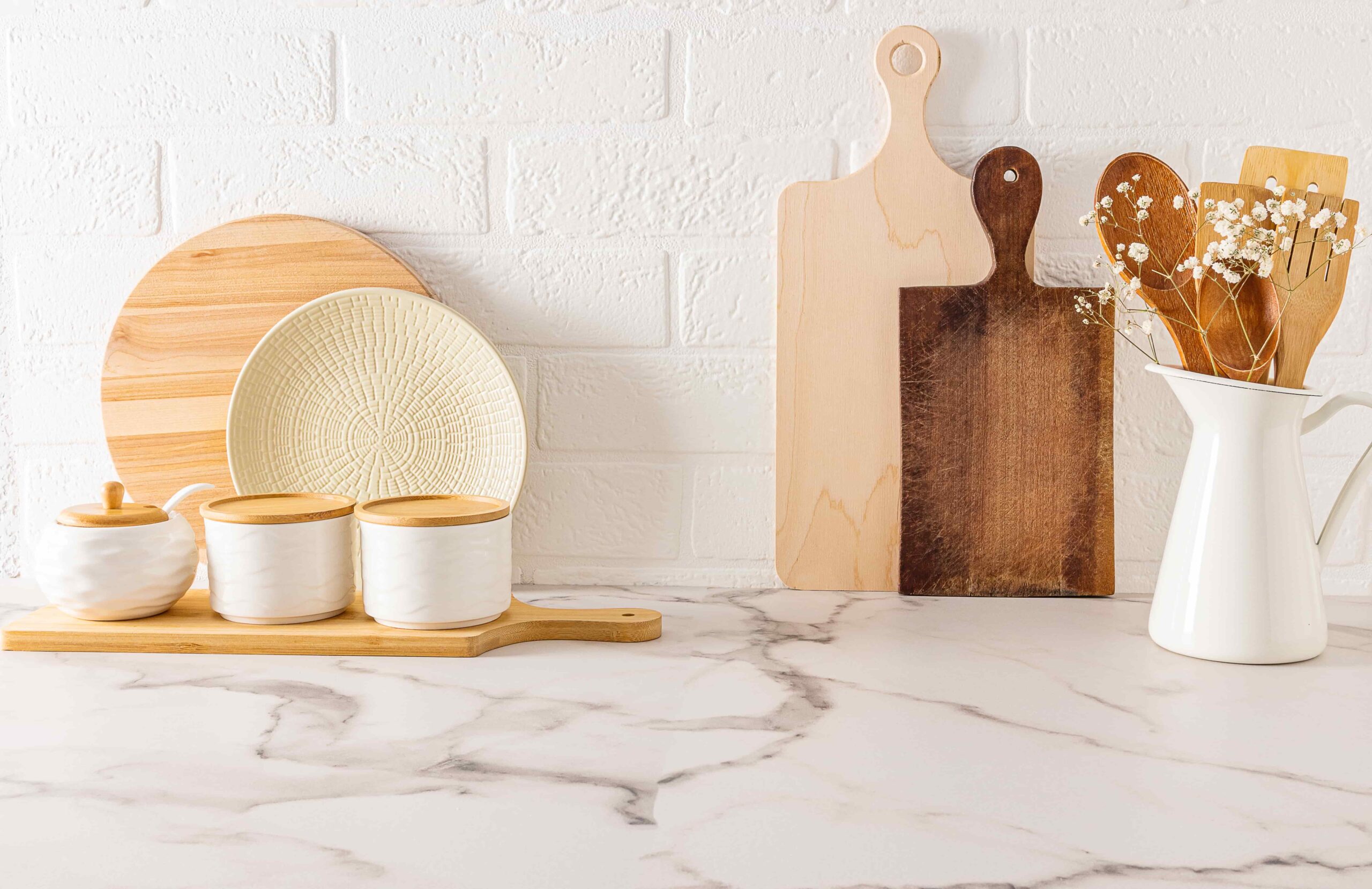Choosing the right type of countertop material is important to enhance the overall look and feel of your space, adding value and a sense of luxury to your home. Besides being visually pleasing, the countertop has to be functional as well – which is why you should pick the right type of stone material based on what it’s used for and how often it’s used.
Importance of Picking the Right Material
Natural stone countertops are very beautiful but very high maintenance and can be costly. They are typically porous and require regular maintenance and periodic sealing. While bathroom countertops are mostly exposed to water and products like soap, kitchen countertops are exposed to acidic foods, scratches, stains, and heat, which is why it is important to choose a material that is durable and resistant to daily wear and tear.
The right material will also be easy to clean and maintain, saving you time and effort in the long run. Sintered stone, granite, and quartz are a few popular choices for stone surface kitchen countertop materials.

Composition and Manufacturing Process
Sintered Stone
Sintered stone is a contemporary material composed of a blend of natural minerals, including quartz and feldspar, as well as pigments and binders. To create sintered stone countertops, the raw materials are transformed into a fine powder before being compacted into a desired mold.
The next step involves a manufacturing process known as sintering. The compacted mixture is placed in a furnace at a carefully controlled temperature that is high enough for diffusion, allowing the particles to bond and solidify the material, while also remaining low enough to prevent melting. The timing of the sintering process is crucial to avoid excessive grain growth, which can weaken the material. Additionally, applying sufficient pressure during sintering ensures the integrity and strength of the final product.
Granite
An igneous rock made through a natural process in the Earth’s crust over millions of years through intense heat and pressure, granite is composed of quartz, feldspar, mica, and other minerals. To create a stone countertop with granite, a large piece of stone is first quarried and cut into slabs. Lastly, it’s polished, honed, and sealed before turning into granite countertops.
Quartz
Another engineered stone product, quartz material is made up of 90-95% natural quartz with resin binders and pigments, and sometimes recycled materials like glass or metallic flecks for various design styles.
To create engineered quartz surfaces, the natural quartz stone is mined from quarries and crushed into fine particles before being mixed with the other materials. It’s then poured into a mold and pressed to remove any air bubbles, and cured at high temperatures, polished, then sealed.
Aesthetics and Design
Since granite is a natural material, it has unique variations in colour and veining pattern, which adds to its aesthetic appeal and elegant appearance. Sintered stone and quartz are available in a wide range of colours and can be engineered to a variety of design options that are very close in appearance to natural stone aesthetics or they can be customised to suit your personal design preferences.
However, quartz offers a larger variety of slab designs with a modern appearance due to its composition of natural quartz, pigments, and resin binders. On the other hand, sintered stone, made purely with natural minerals, mimics the look of natural stone with slabs that look almost exactly like the real thing. Sintered stone tends to come in huge slabs, reducing unsightly joint lines, while quartz provides a modern and versatile design option.
Durability and Maintenance
Sintered stone is an extremely durable material with scratch resistance, heat resistance, stain resistance, and even UV light resistance. It makes the perfect countertop material not only for busy kitchens but for outdoor furniture and flooring as well.
It is non-porous, meaning it doesn’t absorb liquids, making it easy to clean and maintain. However, it is important to note that certain cleaners and harsh chemicals can damage the surface of sintered stone, so it’s important to follow the manufacturer’s guidelines for cleaning and maintenance.
Granite is also known for its durability and heat resistance. On the Mohs scale of mineral hardness, it scores 7 out of 10, making it harder than a knife. However, it is porous and requires regular sealing to prevent stains and bacteria from penetrating the surface.
Granite countertops require daily cleaning using soap and water. However, it is important to be cautious of oils and acids that can potentially stain or damage the sealant, necessitating resealing. While granite is known for its durability, it is worth noting that the sealant may not possess the same level of resilience. Therefore, it is advisable to reseal a granite countertop whenever it is subjected to stains, scratches, severe impact, or heat exposure.
Quartz countertops are also highly durable and resistant to scratches, stains, and heat. Similar to sintered stone, quartz is non-porous and easy to clean. It does not require sealing and is generally low-maintenance. However, it’s important to note that quartz is not heat-proof, and direct exposure to high heat can cause damage to the surface.
Cost
When it comes to cost, sintered stone is generally the most expensive option among the three countertop materials. The manufacturing process of sintered stone involves advanced technology and requires high-quality materials, which contributes to its higher price tag.
Granite falls in the mid-range in terms of cost. The price of granite countertops can vary depending on factors such as the rarity of the stone, its origin, and the complexity of the installation. While there are more affordable options available, high-quality granite can be quite expensive.
Quartz countertops are known for their wide price range, offering options that cater to different budgets. Lower-grade quartz can be more affordable compared to sintered stone and high-end granite, while premium quartz can be similar in price or even more expensive. Factors such as the brand, design, and thickness of the quartz slab can also affect the overall cost.
It’s important to consider the long-term value and durability of the countertop material when assessing its cost. While sintered stone and granite may have higher upfront costs, their durability, and longevity can make them cost-effective choices in the long run. Quartz, on the other hand, offers a balance between cost and durability.
Making the Choice for Kitchen Countertops
Before settling on your choice for kitchen surfaces, there are several things to consider:
Kitchen Design
Will the material fit the aesthetics of the rest of your kitchen space? Do you want your countertops to be the focus or to blend in? Do you prefer the look of actual stone or do you like stone designs in general? Granite has timeless elegance, but sintered stone and quartz have endless design possibilities.
Functionality
How often will you be using the surface? Will you be cooking a lot or not very often? Do you value aesthetics more or functionality more? Choose a material that meets your specific needs. While it is recommended to clean the surface daily with a mild soap or plain water and a clean cloth, more use means more cleaning up spills and stains.
Durability
In high-use areas like kitchen worktops, it’s important that the material has impressive durability such as resistance to heat, resistance to scratches, and resistance to stains. If you have an outdoor kitchen, ensure that the material also has resistance to elements such as rain or direct sunlight.
Maintenance Requirements
Some materials require more care than others. Use stone cleaners recommended by the manufacturer, or a mild soap with a microfibre cloth. Avoid harsh chemicals and acidic products such as lemon juice. If the material is porous, it will require regular sealing and has to be sealed each time there’s damage.
Budget
In addition to the cost of the material itself, there will be installation charges. Each of the materials mentioned in this article requires professional installation. If you are hiring an interior designer, their service costs will also have to be taken into account.
Long-Term Value
Investing in a stone material can add value to your home. Consider the lifespan of each material and how much maintenance it requires. How much are you willing to spend on maintenance such as sealing natural stone tops?
Ideal Choices for Kitchen Countertops
If you don’t cook much, granite is the best choice because of its unmatched natural beauty and unique patterns. If you want something low-maintenance, but with a similar look to natural stone, sintered stone is the best durable kitchen countertop material. And if you want low-maintenance solid surfaces with a uniform appearance, quartz kitchen countertops are for you.

Which Countertop Material Should You Choose?
Before you decide on the material, assess the key differences and advantages of each material. While granite is better for aesthetic reasons, sintered stone and granite are excellent options for countertop materials because of their durability and low maintenance requirements. Granite is porous and requires sealing, while the other two are non-porous and do not require sealing.
Sintered stone has a unique pattern created during sintering, and granite has a unique pattern created when it is naturally created in the Earth’s crust. Quartz has endless design possibilities that can mimic natural stone or have a uniform pattern.
Consider hiring a professional for advice based on your personal preference and to help with renovations. They can also explain the pros and cons of each material, giving you suggestions while keeping the costs under the budget you provide to them.



